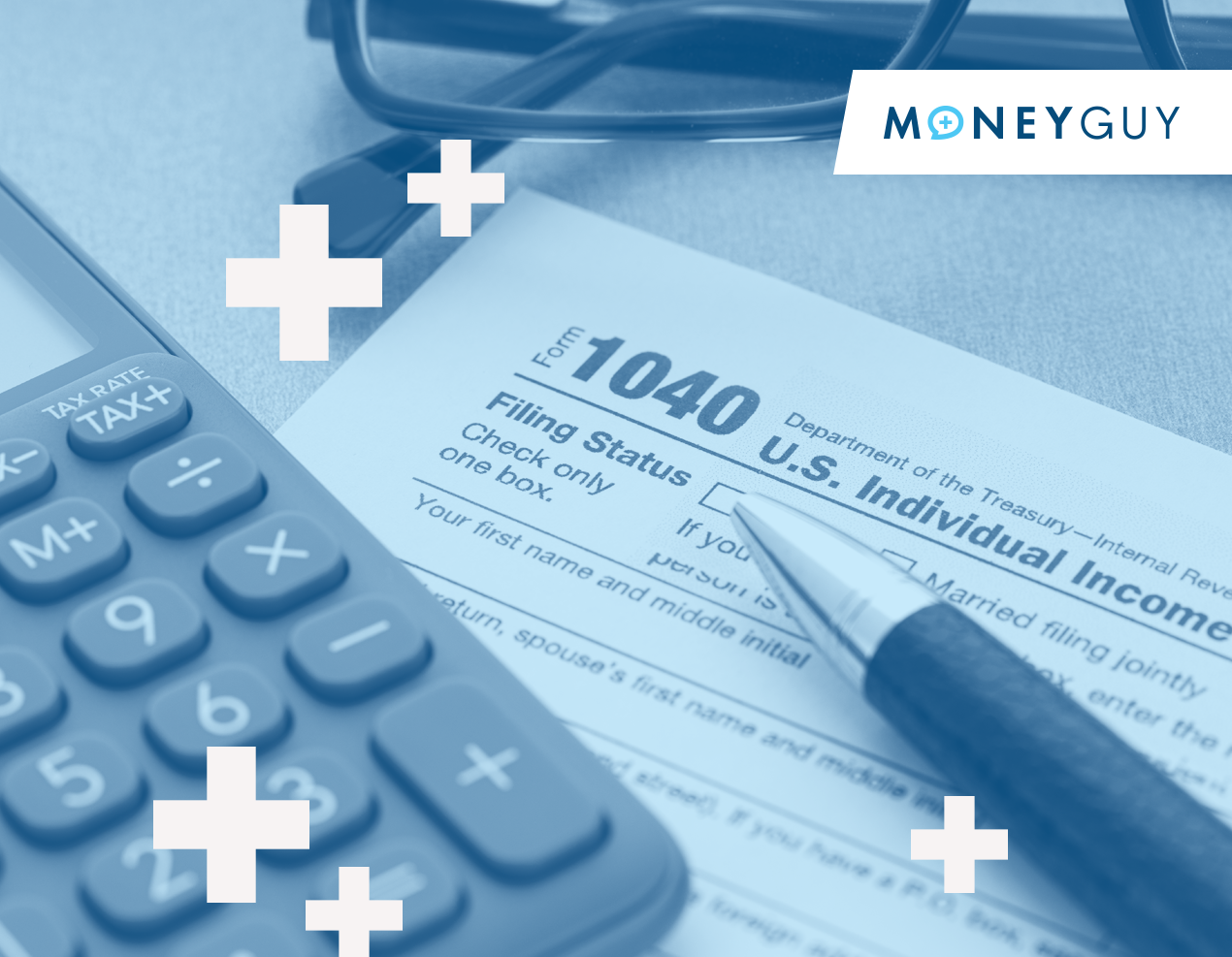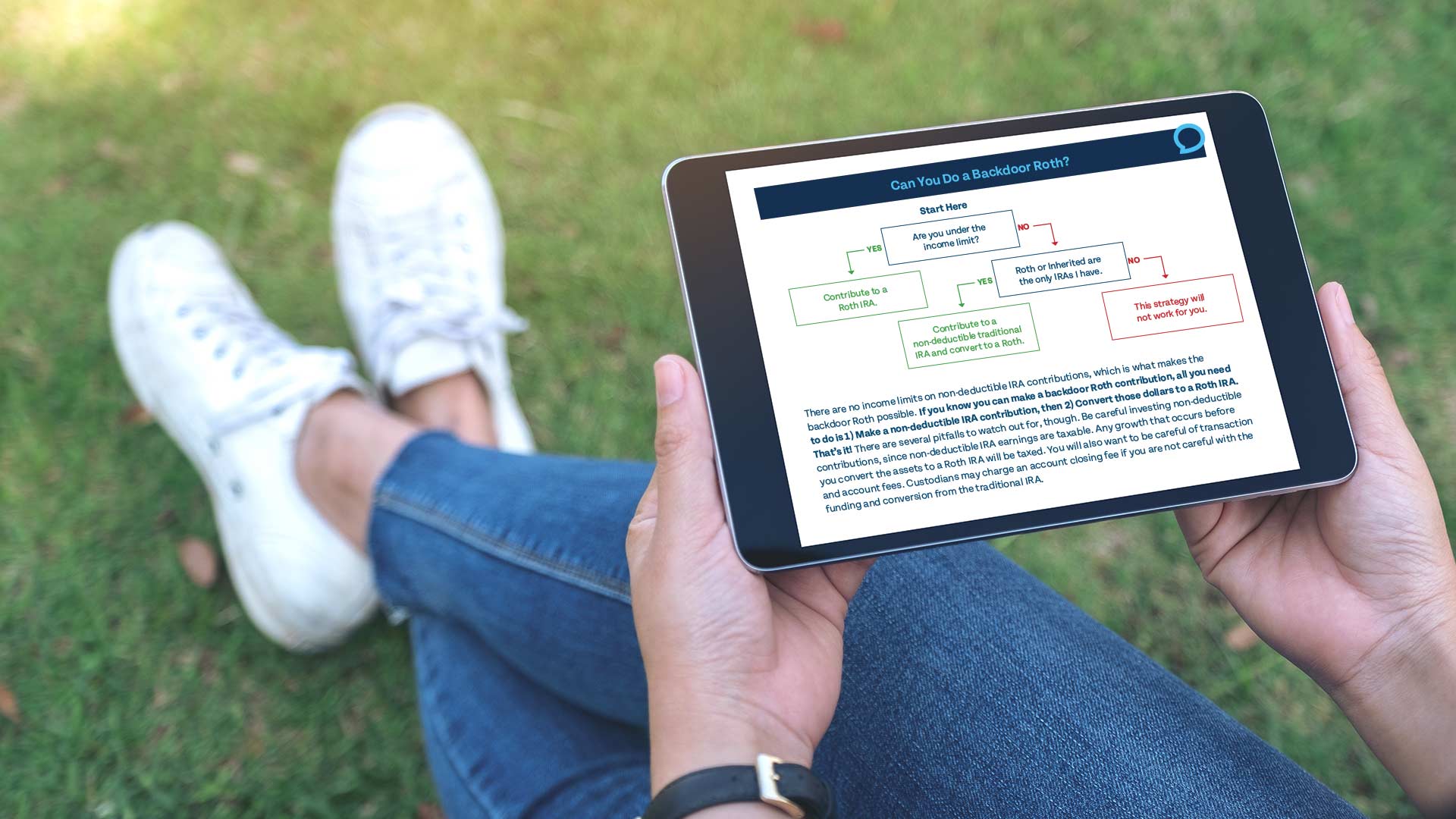
Change your life by
managing your money better.
Subscribe to our free weekly newsletter by entering your email address below.

Subscribe to our free weekly newsletter by entering your email address below.
Tax season is over for most of us, but that doesn’t mean it’s time to stop thinking about your taxes! Planning out your tax strategy in advance can save you time and money on your taxes. In this Q&A, we’ll discuss the line items on your return to pay attention to and how you can optimize your return.
Subscribe on these platforms or wherever you listen to podcasts! Turn on notifications to keep up with our new content, including:
If we can share some tips and tricks for you to hopefully save thousands off of next year’s tax return, I get excited about sharing that info. Think about it; it’s one of the first most powerful tools. Whenever I’m working with a brand new client, I said, ‘Give me that tax return.’ Because if you can show me your tax returns, well, a lot of times it gives me the clues to know how I can help these people do a better job with their personal finances. Instead of keeping that a secret or just something we use as part of our craft, why not share it with the Money Guy family?
This is a great time to do this because we all likely just got back our tax returns. We can very easily look at last year’s return, and we want to walk you through how to look at last year’s return to do some planning for this next year moving forward. So, Brian, let’s jump into the first one, which is kind of exciting. I didn’t have hardly any interest in common in 2022 because you just got your taxes done. You still didn’t have any interest income. You’re probably not keeping your cash in the right place. It’s time for you to go and look beyond that brick-and-mortar bank that’s likely an ungrateful service provider. Yeah, as of this recording, it’s not difficult to go get 4-4.5% on your cash holdings. Just make sure that you select someone if you’re going to use a banking institution. You’ll make sure they’re FDIC insured. If you’re going to use a credit union, make sure they have the additional insurance the credit unions provide. If you’re going to use a money market mutual fund, make sure that the custodian you’re using carries SIPC insurance to make sure that your money stays safe. That’s great.
Let’s talk about dividends. You know that’s a if we, because Schedule B is where you track both your interest and your dividends. This is something to pay attention to, but I want you to kind of explain because a few years it was not the 2018 tax legislation, but it was actually even before that dividends got really good from a tax perspective, but there’s an asterisk next to it. Yeah, one of the things you want to make sure of is that dividends, generally speaking, you know we hear a lot about dividend investing, we hear a lot of folks talk about investing in a way to produce dividends. Well, one of the problems is that a lot of dividends are taxed as ordinary income. So when they flow through in your tax return, you’re paying income on that just like you are your wages. However, there are certain types of holdings that spit out what are called qualified dividends that are paid at more favorable rates than your ordinary income rates. So when you do your tax return, when you go pull your 1099, you ought to very easily be able to look on the dividend line of your tax returns, okay, how much of mine fell into the ordinary category, how much fell into the qualified category? If you see that you have a lot of holdings inside your taxable brokerage account that are spitting out tons of ordinary income dividends, maybe it’s time for you to take a look at your asset location to see if perhaps those holdings in the taxable account would be better served to be held in a pre-tax account like a 401k or an IRA.
By the way, if you have a curiosity what’s the difference? Qualified dividends are the dividend evidence that you get from being a dividend investor when Starbucks issues a dividend, or Coca-Cola, or even Apple – that’s qualified dividends. When mutual fund companies buy and sell Securities and it’s less than 12-month holdings, those are short-term transactions, they also get classified as dividends, but they’re considered ordinary. You just want that qualified number to be the lion’s share of your total ordinary income number. The other thing that we want to draw your attention to is ordinary dividends. The IRA distribution line is the most common mistake that we see made on tax returns year over year. A lot of our clients, a lot of the folks with whom we work, are doing backdoor Roth conversions. Well, if you’re doing back to a Roth conversions, you do have IRA distributions that are taking place throughout the course of the year, but if you do not fill out the tax form correctly, if you’re not accurately tracking the basis inside of your traditional IRAs, it’s not uncommon for those distributions to show up as a taxable amount. So, it’s a surefire giveaway of one of our clients when we look at their tax return, and it shows taxable distributions at twelve thousand dollars or this, you’re going to thirteen thousand, and we know that they’ve been doing non-deductible after-tax contributions into their traditional IRAs. It’s an immediate red flag. They are paying taxes that they do not have to pay. So, if you are perpetrating that strategy, make sure that your distributions do not fall into the taxable distribution line. Yeah, and don’t just trust what your custodian puts on the 1099s because if you’ll notice, a lot of custodians, even if you did a Roth conversion appropriately, they’re going to the box that will there will be a box on your on the 1099 that says taxable amount not determined because let’s go list the taxable amount will be the full amount of the distribution. Your custodian doesn’t know how you’re actually going to fill it out on the form, and that’s why the second clue we like to share with people, though, is that, and I’m always surprised at how many tax returns that people just are not completing this form because it is optional but necessary if you’re using these type of strategies, that form 8606, go.
If you’re doing backdoor Roth conversions, and you go look at your tax return, and you do not see an 8606 in the stack of forms, you need to talk to your tax preparer and say, hey, why are we not actually completing this because I want to make sure we’re doing this appropriately. And a lot of times, even when the 8606 is completed, it’s not completed accurately. So, we thought as a quick example, we’ll show you what a sample 2022 8606 should look like. As a reminder, it’s two pages. A lot of folks want to do the first page, but it’s a two-page form that just walks through, did I make contributions, did I convert the contributions, what’s my IRA balance, and it will calculate for you the taxable amount of the distribution, which, if you’re doing back doors the right way, should be zero. So, make sure that these are filled out correctly. Don’t pay taxes unnecessarily that you don’t need to. Another big thing to pay attention to when we’re doing planning, especially for folks that are close to retirement in retirement because Social Security is one of those things you need to be very aware of how it’s going to be taxed because there are a lot of planning opportunities, but if you’re still working and have reached the age of Social Security, don’t be too quick to assume that you should go ahead and start firing up the benefits. You might actually be hurting yourself on the taxability of it. Similarly, if you’ve left the workforce and are trying to figure out how much of this is going to be taxable versus how much is going to be tax-free, we’ve got the answer for you.
Perhaps you’re someone who, in retirement, has built your three buckets well and can control where your income comes and goes, so you can control what level of income you have. What you may not realize is that there’s actually a portion of income where your Social Security benefits aren’t taxed at all. Then, at the next chunk, only 50% of the amount of your benefit is taxed, and once you cross over a certain income threshold, up to 85%. We often see clients with income that we can manipulate, quote-unquote, where we can capitalize on not having their Social Security benefits taxed, and we can also capitalize on the zero percent capital gains rates by controlling your income fluctuation. So, if you’re someone who is retired and can control your income, make sure you’re paying attention to this. Again, you don’t want to pay more tax than you have to, and some very small tweaks in your plan can actually drive the tax bill down to a super low amount.
The next big thing that people should know about is itemized deductions. It wasn’t that more people used to qualify for this, but then after the tax reform of 2018, now the standard deduction is so big that for most people, it’s almost $26,000 for married couples. So, I want you to immediately go look at last year’s tax return and see if you took the standard deduction or itemized. How close were you? Were you really close or were you barely over? All of this will have an impact on how you should do planning going forward. There are a lot of times where you can actually group the deductions that you’re taking. If you go look at your Schedule A, your itemized deduction, obviously, you have the medical expense deduction, then you have the taxes that you pay, then you have mortgage interest, then you have gifts. It might be possible to combine some of those instead of doing them in two separate tax years into one tax year. Charitable planning is one that we see most often. If you are just barely getting over the standard deduction each year, maybe instead of trying to get over the standard deduction this year, you say next year, “I’m going to double up my deductions” and get a larger percentage of those contributions deductible. It’s a great way to save on your lifetime taxes. So, make sure you’re paying attention to Schedule A on your tax return.
Now, this next one that I want to mention is a big one because it’s a credit, not a deduction. The difference between those two is that a deduction just lowers your taxable income, so that’s good, but it just takes a lot of deductions to really lower the taxes. A credit means a dollar-for-dollar benefit, meaning if you can get a credit, it lowers how much the taxes are going to be, dollar for dollar. This one’s a powerful one. One of the biggest ones that people deal with is the child tax credit. This is a big one that has been changing in the last couple of years. The expanded child tax credit that a lot of us heard through the pandemic no longer exists, but the OG (original) Child Tax Credit is, in fact, still around in 2023. The credit is worth up to two thousand dollars per qualifying child, and up to fifteen hundred dollars of that is refundable. So, even if you are receiving more money back than you paid into the system, that’s allowed if your income falls within the threshold where you can take advantage of the Child Tax Credit. People will get this, by the way. This has gone up a lot under some of the tax reforms. For single individuals, it’s up to two hundred thousand dollars, and for a married couple, it’s four hundred thousand dollars. So, I mean, there are a lot of folks that qualify. If you have kids, you’re more than likely going to qualify for this tax credit. Just pay attention because it’s a big one. And again, this is one of those things where it’s based off of an income threshold. So, if you find that as a single person when you look at your tax return, your modified adjusted income is close to that 200,000 mark, or as a family, you’re close to that 400,000 mark, maybe there are some adjustments you could make on the decisions you’re making right now. Like, how am I contributing to my 401k? Am I doing pre-tax? Am I doing Roth? If you can think about those things, it’s not incredibly impossible to drive your income down so that you qualify for some of these benefits.
Okay, here’s the next one: is amount owed refund, no? If you have a refund, it’s not the worst thing in the world if it’s just a little bit. But if it’s a huge refund, be careful because remember cash is not trash anymore. You could actually be earning over four percent of that for yourself. So, if you have big refunds, pay attention to what’s going on with your owed versus refund amount. This is the easiest thing to use on your last year’s tax return. If you owed a substantial amount to the government, you probably got some vouchers to say, “Hey, maybe you need to start making some estimated tax payments.” Well, that may not be necessary if you can adjust your withholdings at work. If you got a big refund, the exact same thing. Maybe you want to adjust your withholdings at work. In an ideal world, in the best scenario for most folks, if you could get the amount owed or amount refunded to zero, that would be perfect. That would mean that you hit the bullseye. So, you want to get as close to that number as you can so that you don’t potentially run into tax penalties, which we’ll talk about. And also, like you said, you’re not missing out on the opportunity cost of having those dollars work for you.
That is a good second way into penalties because I think penalties that they many times in taxes, they are a warning signal for me. If I review a tax return, I see penalties, I’m like, “Oh man, people already, we don’t love overpaying on taxes, but to see penalties that we’re going to give more money to the government just off of mistakes or not paying enough money early enough to the government, when they wanted, to pay attention to this because there are safe harbor provisions where if you will just pay attention because we understand there are some of you financial mutants, your income is going to fluctuate all over the place. The government also understands that your incomes go fluctuate, so they give you some provisions that allow you to safely pay in a certain amount just to protect you from paying unnecessary penalties to the government and if you’re curious about those amounts, I’m just going to read this to you: the IRS will not charge a penalty if you pay at least 90% of the tax owed for the current year or 100% of the tax owed for the previous year, unless you’re considered a high-income individual. The safe harbor for high-end income taxpayers is paying 110% of last year’s tax bill. So, what most folks do to make sure they keep themselves above board is to look at last year’s tax return, figure out the total amount of tax owed, and then make sure they withhold or pay in at least 110% of last year’s bill. Then, they’re likely to avoid any penalties being assessed.
I’ll close out this segment with something I think is a very powerful tool. Since we just finished tax preparation season, a lot of people have their freshly minted tax returns. I like using several data points from the tax return – your total income, how much you’re giving – to figure out if you’re saving and investing appropriately. You can marry this with our Net Worth Tool at learn.moneyguy.com. We ask you what your income is, and then you get to compare that to the net worth you have. This is a great way to turn this negative compliance thing that the government makes us do into a positive for your personal financial life. Alright, guys, none of us love paying taxes.
For more information, check out our Tax Guide here.


When Should I Claim Social Security?
Social Security can have big impacts on your retirement. But knowing when to draw Social Security can depend on a…
View Resource
Tax Guide 2025
Updated for 2025! Ever wonder what the highly trained professionals use to tax plan? Wonder no more! We’ve assembled the…
View Resource
Tax Guide 2024
Updated for 2024! Ever wonder what the highly trained professionals use to tax plan? Wonder no more! We’ve assembled the…
View Resource
I Have a Lot of Money, but I Don’t Feel Wealthy!
Read MoreThe Best Tools for Filing Your Taxes in 2025
Read MoreThis Is What Tax Planning Really Means
Read More

How about more sense and more money?
Check for blindspots and shift into the financial fast-lane. Join a community of like minded Financial Mutants as we accelerate our wealth building process and have fun while doing it.




It's like finding some change in the couch cushions.
Watch or listen every week to learn and apply financial strategies to grow your wealth and live your best life.
Subscribe to our free weekly newsletter by entering your email address below.